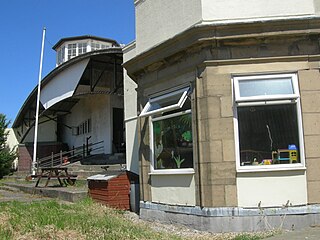| Grimbergen Airfield Recreatief Vliegveld Grimbergen (Advanced Landing Ground B-60) | |||||||||||
|---|---|---|---|---|---|---|---|---|---|---|---|
 | |||||||||||
| Summary | |||||||||||
| Airport type | Private | ||||||||||
| Location | Grimbergen, Belgium | ||||||||||
| Elevation AMSL | 69 ft / 21 m | ||||||||||
| Coordinates | 50°56′55″N004°23′31″E / 50.94861°N 4.39194°E Coordinates: 50°56′55″N004°23′31″E / 50.94861°N 4.39194°E | ||||||||||
| Website | www | ||||||||||
| Map | |||||||||||
| Runways | |||||||||||
| |||||||||||
Grimbergen Airfield - locally known as Vliegveld Grimbergen - ( ICAO : EBGB) is a general aviation aerodrome located in Grimbergen, a municipality of the province of Flemish Brabant in Belgium. Like many recreational aerodromes in Belgium, it is formally a private field, requiring prior permission to land from visitors. The airfield is home to motorized aircraft, either privately owned or belonging to two active aeroclubs. It also hosts an aircraft repair and maintenance company.

The ICAOairport code or location indicator is a four-letter code designating aerodromes around the world. These codes, as defined by the International Civil Aviation Organization and published in ICAO Document 7910: Location Indicators, are used by air traffic control and airline operations such as flight planning.

General Aviation (GA) represents the 'private transport' and recreational flying component of aviation.

Grimbergen is a municipality in the Belgian province of Flemish Brabant, 10 km north of the capital Brussels. It comprises the towns of Beigem, Grimbergen, Humbeek and Strombeek-Bever. In 2017, it had a population of 37,030 and an area of 38.61 km2, giving a population density of 959 inhabitants per km2.
Contents
There are two remarkable hangars on the airfield, constructed in 1947 by builder-architect Alfred Hardy (architect). Looking more like silos, they are in fact round hangars made of concrete. [2]

Alfred Hardy (1900–1965) was a Belgian contractor and autodidact architect. He became internationally known for his thin-shell concrete constructions in the 1950s and 1960s.

Concrete, usually Portland cement concrete, is a composite material composed of fine and coarse aggregate bonded together with a fluid cement that hardens over time—most frequently a lime-based cement binder, such as Portland cement, but sometimes with other hydraulic cements, such as a calcium aluminate cement. It is distinguished from other, non-cementitious types of concrete all binding some form of aggregate together, including asphalt concrete with a bitumen binder, which is frequently used for road surfaces, and polymer concretes that use polymers as a binder.
The airfield was first created in 1939 by Belgian military, and came to full development by German occupation forces. After the war, it hosted the pilot's school of Belgian flag carrier Sabena.

The Societé Anonyme Belge d'Exploitation de la Navigation Aérienne,, better known internationally by the acronym Sabena or SABENA, was the national airline of Belgium from 1923 to 2001, with its base at Brussels National Airport. After its bankruptcy in 2001, the newly formed SN Brussels Airlines took over part of Sabena's assets in February 2002, which became Brussels Airlines after a merger with Virgin Express in March 2007. The airline's corporate headquarters were located in the Sabena House on the grounds of Brussels Airport in Zaventem.
In 1989, as part of a political reorganisation, the aerodrome was passed from the Belgian national authority RLW/RVA to the regional Flemish government, who closed it soon after. The aerodrome reopened in 1997 at the hands of a private not for profit association, who have been running it since. A large part of the aerodrome had to be given up however, to be transformed into a forest, Lintbos.

















